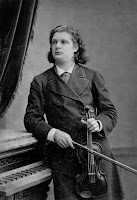 |
| Duo Syncopa at Collage, San Pedro. |
REVIEW
Duo Syncopa, Chamber Music Tuesday, Collage, San Pedro
DAVID J BROWN
The venue
Collage opened its doors as “A Place For Art and Culture” in the city of San Pedro in May 2020. This, as Executive Director Richard Foss acknowledges, was spectacularly bad timing for that one reason familiar worldwide, but nonetheless the organization managed to keep going through the months and years of the Covid pandemic, and now with that mostly in the rear-view mirror hosts over 100 events annually.
 |
| Tomomi Sato. |
Behind its unobtrusive former shop-front façade in South Pacific Avenue, Collage mounts art shows, poetry readings, author presentations, and vocal, jazz, folk, blues and band concerts, as well as running cultural outreach activities such as its
enterprising program to collect unwanted band instruments, refurbish them when necessary, and then donate them to local young musicians otherwise unable to fulfil their aspirations.
 |
| Yue Qian. |
But until last Tuesday, Collage’s calendar had not included classical chamber music. This changed when, in the first of what is hoped to be a regular series of recitals on the first Tuesday of each month, Duo Syncopa (
Yue Qian, violin;
Tomomi Sato, piano) presented a program of 19th and 20th century works as unhackneyed as it was ambitious.
Being used to the sumptuous Steinways deployed at other local South Bay venues used by
Classical Crossroads, Inc. and the
South Bay Chamber Music Society, I was slightly wary at first sight of Collage’s clearly vintage baby grand, but under Ms. Sato’s energetic steel fingers its light, well-tuned tones rang out cleanly in the small, attractively-lit, timber truss-roofed, and brick-lined performance space.
 |
| Toru Takemitsu. |
Duo Syncopa opened with Toru Takemitsu (1930-1996), the first Japanese composer to gain international familiarity, and his early
Distance de fée (1951) clearly shows what he had already learned from Debussy and Messiaen. Across its seven-minute span, outer sections of tonally unmoored musings enclose a more vigorous but fragmentary center, whose rapid and extreme shifts of violin technique—from high harmonics to double-stopping to rapid
tremolando—held no terrors for Ms. Qian.
 |
| Leos Janáček. |
From here it was a step back a generation or so to Janáček’s single
Violin Sonata JW 7/7 of 1914. Its superficially conventional four-movement structure (compressed sonata-design outer movements complete with exposition repeats—both observed by Duo Syncopa—enclosing a
Ballada slow movement and
Allegretto scherzo-and-trio (not named as such)) fails to conceal the sonata's astonishingly contemporary sensibility, with restlessly changing textures and extremes of dynamic range that push the capabilities of both instruments to the limit.
Fortunately each player was equal to these expressive demands: Ms. Qian eloquent in Janáček’s passionate but fragmentary melodies and hovering on the edge of audibility in the stratospherically high conclusion to the first movement, and Ms. Sato encompassing alike the hammering chords and teemingly arpeggiated piano part.
 |
| Eugène Ysaÿe in 1883. |
After this, the first half ended with some “light relief,” Eugène Ysaÿe’s
Caprice d'après l'étude en forme de Valse de C. Saint-Saëns Op. 52, No. 6 (1877), in which Ms. Sato’s accompaniment gleefully egged Ms. Qian’s violin on to ever more extravagant spins of aural
schlagobers, as well eliciting audience laughter with her increasingly teasing returns to Saint-Saëns’ innocent little tune.
After a short interval Duo Syncopa moved a couple of generations further back to one of Beethoven’s most trenchant early/middle-period works, the Sonata No. 7 for Piano and Violin in C Minor Op. 30, No. 2 (1801-02). Here they were as sharply-accented and propulsive in the outer movements and the scherzo (no easing of pace for the trio section) as they were tender and full of inner feeling in the Adagio.
 |
| Robert and Clara Schumann. |
The duo concluded their program, effectively as an encore, with the second of the
Three Romances, Op. 94, that Robert Schumann wrote in December 1849 and gave to his wife Clara as a Christmas present. Though originally written for oboe and piano, they work equally well with violin, as Duo Syncopa’s performance demonstrated—simple and heartfelt as its “
Einfach, innig” title. It's good to know that these fine performers have already been booked by Classical Crossroads for its next season of
First Fridays at First~fff! recitals.
As has been reviewed on LA Opus many times, the South Bay area is spectacularly well served with chamber music recitals of the highest artistic quality by organizations already noted such as Classical Crossroads and the SBCMS, but this was the first for downtown San Pedro, brought about with the help of local chamber music enthusiast and “fixer” Thomas Tileston. Let’s hope it heralds many to come!
---ooo---
Chamber Music Tuesday, Collage, 731 South Pacific Avenue, San Pedro, 7.30pm, Tuesday, May 9, 2023.
If you found this review to be useful, interesting, or informative, please feel free to Buy Me A Coffee!




















No comments:
Post a Comment